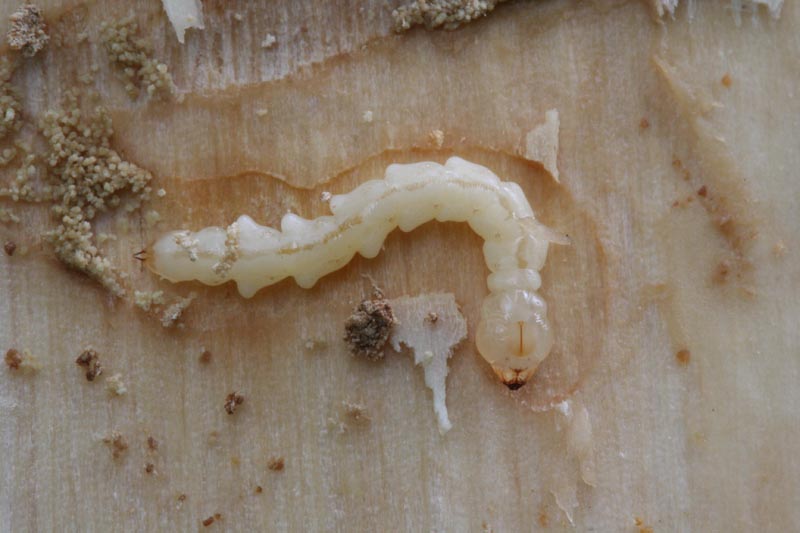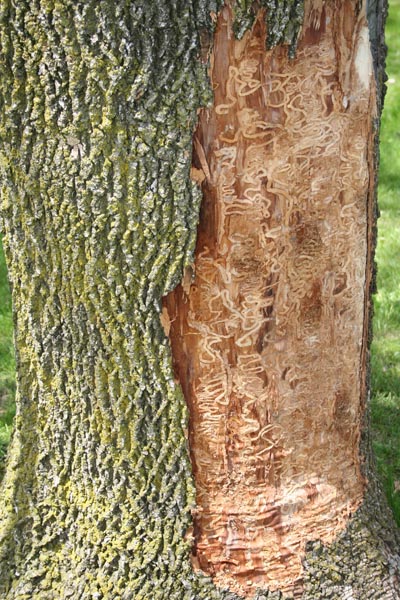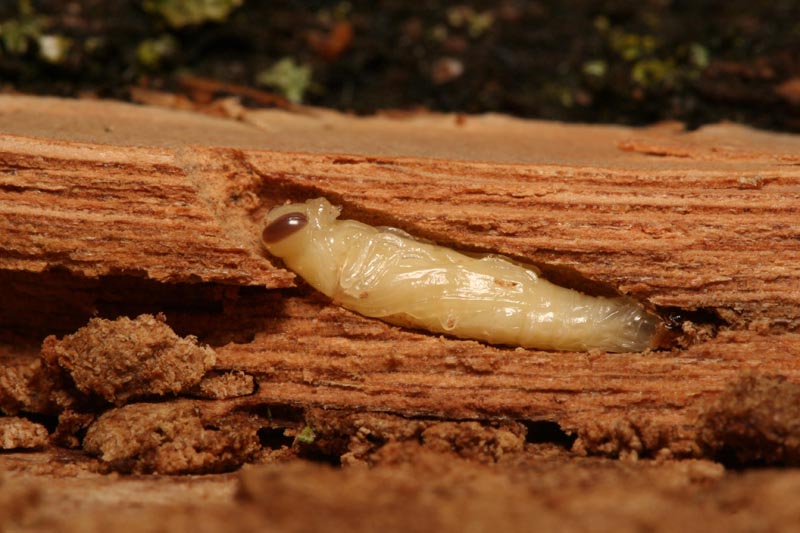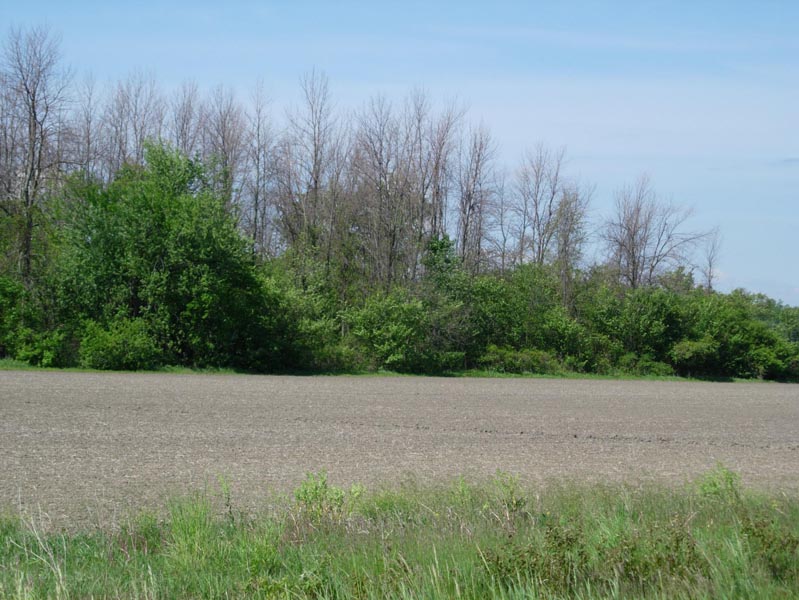Emerald ash borer

- Order: Coleoptera
- Family: Buprestidae
- Latin: Agrilus planipennis Fairmaire
- English: Emerald ash borer
- French: Agrile du frêne
Control
Laws
This insect is one of the pests regulated by the Canadian government and is the subject of the following policy directives:
Directives
- D-98-08: Entry Requirements for Wood Packaging Materials Produced in All Areas Other than the Continental United States
- D-02-02: Plant Protection Import Requirements for Rooted, or Unrooted Plants, Plant Parts, and Plants In Vitro for Planting
- D-02-12: Import requirements of non-manufactured wood and other non-propagative wood products, except solid wood packaging material, from all areas other than the continental United States
- D-03-08: Phytosanitary Requirements to Prevent the Introduction into and Spread Within Canada of the Emerald Ash Borer, Agrilus planipennis (Fairmaire)
Prevention
Canadian and U.S. authorities have given up the strategy of trying to eradicate the emerald ash borer and instead are turning to measures to accommodate and manage this pest (Bauer et al. 2008). Quarantine measures coupled with better detection techniques (Lyons et al. 2007) may prevent small infestation centres from spreading. To date, the main pathway for the spread of the insect appears to be the transport of infested materials, nursery stock and natural dispersal (CFIA 2008; Anonymous 2008; Liu and Bauer 2008).
Control
1. Mechanical and silvicultural
Cutting down infested trees and burning or burying the wood can help reduce emerald ash borer populations and slow their spread, particularly when infestation centres are small. Salvage cutting of affected trees in woodlots within regulated areas can be done but it is expensive. Logs can be cut up since the borer does not penetrate very deeply into the wood but whole logs must not be taken out of regulated areas and all residues must be destroyed.
2. Chemical
The systemic insecticide imidacloprid, applied either through trunk injections or soil drenching, has been tested in the United States (GISD 2008). Emamectin benzoate is another systemic insecticide that has shown some promise in the United States. Special permission from the authorities for its use in Michigan, Indiana, Ohio, Illinois and West Virginia was obtained in 2007 (Anonymous 2008).
In Canada three active ingredients are registered for controlling the emerald ash borer by trunk injection : acephate, imidacloprid and azadirachtin.
Caution
There are many different chemical pest control products available. They may be toxic to plants, animals, humans or the environment in general. A number of these products pose potentially lethal risks to humans. To protect human health and the environment from pesticide-related risks, Canada adopted the Pest Control Products Act (PCPA). The Pest Management Regulatory Agency (PMRA; http://www.hc-sc.gc.ca/ahc-asc/branch-dirgen/pmra-arla/index-eng.php) is responsible for administering the Act. A pesticide product label indicates the class designation (domestic, commercial, agricultural), the potential risks to human health and the environment, and the conditions and restrictions pertaining to product use. Compliance with the label directions and restrictions is mandatory. The provinces may also regulate the use of pesticides within their respective territory. For more information on these products, contact PMRA at the following E-mail address: pmra.infoserv@hc-sc.gc.ca
3. Biological
Spraying the trunk and foliage with the entomopathogenic fungus Beauveria bassiana strain GHA (only strain HF 23 is registered in Canada) has shown promise when applied before adult emergence (Liu and Bauer 2008). However, there are not enough data to assess how well this product protects trees from emerald ash borer attack (GISD 2008)
Two parasitoids, Tetrastichus planipennisi and Spathius agrili, were released in Michigan in 2007 to improve the very low parasitism rates observed in the United States (Bauer et al. 2008). It is still too early to assess the effectiveness of these biological control agents. Studies on another parasitoid (Hui et al. 2008) are under way.
4. Genetic resistance
The hybridization of North American ashes with Asian species could produce trees more able to resist attack by the emerald ash borer (Rebek et al. 2008).
5. Stages in an integrated disease management program
Studies are under way on establishing an integrated management strategy for the emerald ash borer. The use of parasitoids, already attempted in Michigan, is promising but we will have to wait for results from recaptures and parasitism measurements before determining how effective these measures actually are. Although the entomopathogenic fungus Beauveria bassiana strain GHA provides an alternative to pesticides, its effectiveness in preventing attacks remains to be seen. Promising systemic insecticides are already available on the U.S. market and allow ornamental trees to be saved.Control cannot be achieved at the stand scale. Infested trees still have value on the pulp and lumber markets since the emerald ash borer only attacks the outer layers of the sapwood. In regulated areas, usable trees can be sawn on site with a portable sawmill. Logging and sawmill residues must be burned, chipped or buried. Before proceeding, operators must contact the Canadian Food Inspection Agency (Rose et al. 2006).
For ornamental trees, Rebek and Smitley 2007 recommend that the following treatments should only be done if the trees are in a quarantined area:
- Maintain trees in overall good health by fertilizing them and watering them during dry periods.
- Infested trees exhibiting between 20% and 40% dieback can be treated with acéphate systemic insecticide.
- Trees with over 40% dieback should be felled.
- Trees with a greater diameter should be treated annually.
References
References
- Agence Canadienne d’Inspection des Aliments (ACIA) 2008. Agrile du frêne, Agrilus planipennis Fairnaire. http://www.inspection.gc.ca/francais/plaveg/pestrava/agrpla/agrplaf.shtml consulté le 2 mars 2009.
- [Anomyme]. 2008. http://www.emeraldashborer.info/treeage.cfm consulté le 2 mars 2009
- Bauer, Leah S.; Liu, Houping; Gould, Juli, 2008. Progress on biological control of emerald ash borer. In: Mastro, Victor; Lance, David; Reardon, Richard; Parra, Gregory, comps. Emerald ash borer research and development meeting; 2007 October 23-24; Pittsburgh, PA. FHTET 2008-07. Morgantown, WV: U.S. Department of Agriculture, Forest Service, Forest Health Technology Enterprise Team: 56-58.
- Global Invasive Species Database (GISD), 2008.Agrilus planipennis Available from: http://www.issg.org/database/species/management_info.asp?si=722&fr=1&sts=sss&lang=EN consulté le 2 mars 2009.
- Liu, H. P., and L. S. Bauer. 2008. Microbial control of Agrilus planipennis (Coleoptera: Buprestidae) with Beauveria bassiana strain GHA: field applications. Biocontrol Sci. Technol. 18: 557-571.
- Lyons, D.B.; Caister, C.; De Groot, P.; Hamilton, B.; Marchant, K.; Scarr, T.A.; Turgeon, J.J. 2007. Survey guide for detection of emerald ash borer. Natural Resources Canada, Great Lakes Forestry Centre, Sault St. Marie, Ontario, Canadian Food Inspection Agency. 52 p. http://warehouse.pfc.forestry.ca/glfc/26858.pdf consulté le 2 mars 2009
- Rebek, Kimberly A., and Smitley, David R. 2007. Homeowner guide to emerald ash borer treatments Michigan State University Extension Bulletin E-2955. http://www.emeraldashborer.info/files/E2955.pdf consulté le 2 mars 2009
- Rebek, Eric J.; Herms, Daniel A.; Smitley, David R. 2008. Interspecific Variation in Resistance to Emerald Ash Borer (Coleoptera: Buprestidae) Among North American and Asian Ash (Fraxinus spp.). Environm. Entomol. 37: 242-246.
- Rose, B., Williams, S., Czerwinski, E., Scarr, T., Pollard, J., Tucker, L. 2006. Manuel du propriétaire de terres à bois menacées par l’agrile du frêne. Ministère des ressources naturelles de l’Ontario. http://www.mnr.gov.on.ca/259631.pdf consulté le 2 mars 2009.
- Wu Hui, Wang XiaoYi, Li MengLou, Yang ZhongQi, Zeng FanXi, Wang HongYan, Bai Ling, Liu SongJun, and Sun Jin. 2008. Biology and mass rearing of Sclerodermus pupariae Yang et Yao (Hymenoptera: Bethylidae), an important ectoparasitoid of the emerald ash borer, Agrilus planipennis (Coleoptera: Buprestidae) in China. Acta Entomologica Sinica 51: 46-54. CAB Abstracts, EBSCOhost (accessed February 27, 2009).
Authors
Auditors
Auditors
Robert Lavallée





